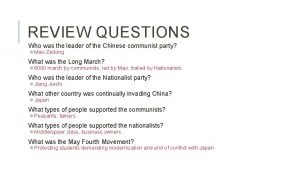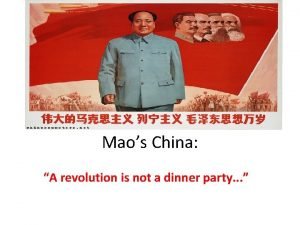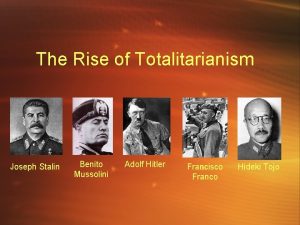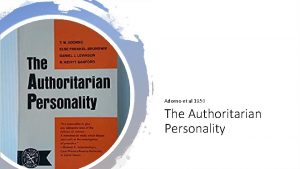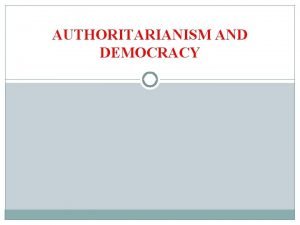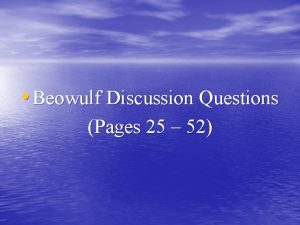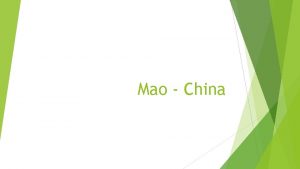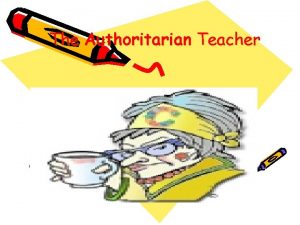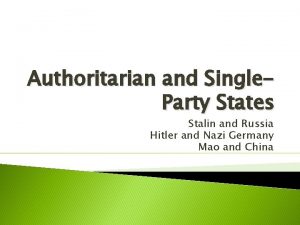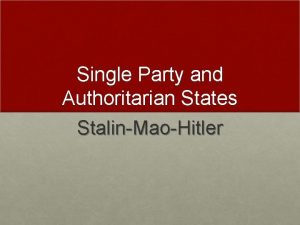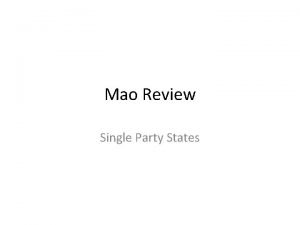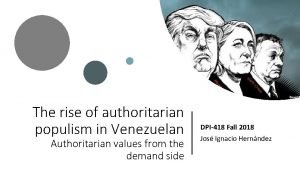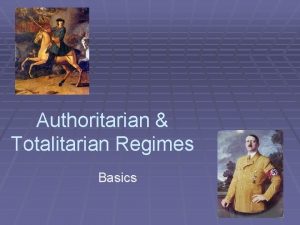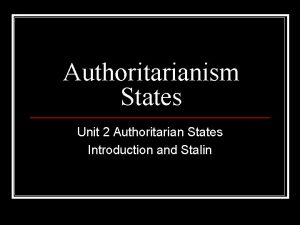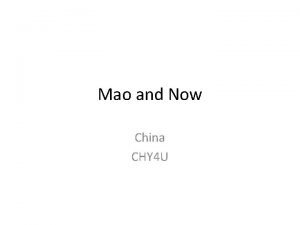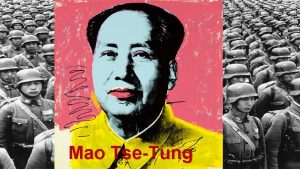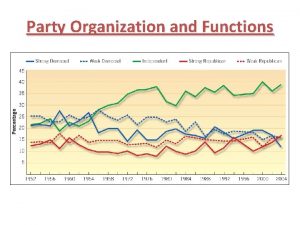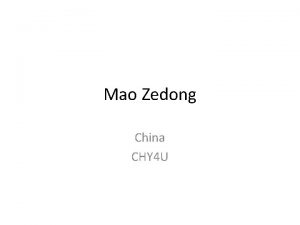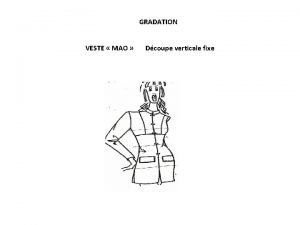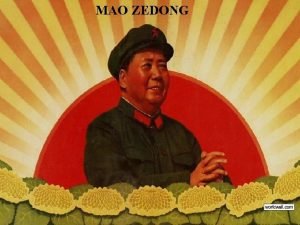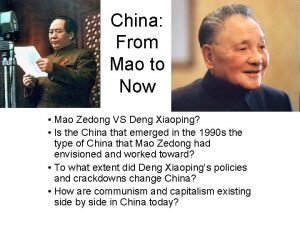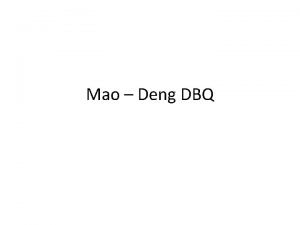Origins of Mao Authoritarian and Single Party States






















- Slides: 22

Origins of Mao

Authoritarian and Single. Party States - China October 1949, in front of 500, 000 people, Mao proclaimed the Chinese people had stood up People’s Republic of China Result of a protracted struggle between CCP and GMD Warlord Period 1916 -1927 Nanjing Decade 19291937 Sino-Japanese War 19371945 Chinese Civil War 19461949 Mao emerged the winner

Mao’s Background Born in 1893, small farming village called Shaoshan, Hunan province Parents farmers, standard of living acceptable Attended local school “The Dismemberment of China” was to have a strong influence Still remembered opening line “Alas, China will be subjugated. ”

Mao’s Background End of the 19 th century, China was undergoing intense pressure externally and internally Meiji Restoration of 1868, Japan rising Evident after 1894 -95 Sino -Japanese War and 190405 Russo-Japanese War Led to annexation of Korea

Reviewing China’s Problems Pressure for change Qing Dynasty ruled since 1644 1867 -1908 resistant to reforms 1898 movement Hundred Days of Reform had been rejected Overthrow Double Tenth Revolution, Oct. 10, 1911 Led by Sun Yixian and what became the Guomindang in 1912 Three Principles

Reviewing China’s Problems Crucial impact on Mao’s thinking was anti-Western attitude Open Door Policy of USA in 1898 Economic imperialism in China German acquisition of Shandong and subsequent railroad construction 1900 Boxer Rebellion

Reviewing China’s Problems Sun’s success short-lived Conflict with Yuan Shikai’s death in 1916 led to warlord period De Facto government in Beijing Allowed for other nations to reassert influence Mao would encounter this throughout this period

Mao’s Influences Four major influences Aggressive and expansionist Japanese foreign policy that sought raw materials Ruling elite that ignored the needs of rural villages and exploited the peasants Perception that the West was attempting to exploit China Issue of regionalism

Other Mao successful as a student, graduated from Changsha Middle School in 1918 Age 24, left his family and moved to Beijing worked at the university Became a bookseller, teacher, school principal, businessman Always read Access to Western classics Very influential The Wealth of Nations by Adam Smith Started to write articles for newspapers 1919 Hunan independence activism

Paris Peace Settlements and Impact on China Mao’s activism began around this time Japan had gotten Shandong Had been the opposite expectation of China May 4, 1919 thousands marched on Beijing in protest, Twenty-One Demands Mao had been in contact with Russian Comintern now Noted how the West was attempting to overturn Communism Movement paved the way for the emergence of CCP Formally established in 1921 12 delegates, including Mao Branches all over China

Growth of the CCP Coalition formed with GMD to take out warlords and foreign powers Suggested by the Comintern First United Front in 1924 Affect on CCP was huge 57 members in 1921 to 980 in 1925 to 58, 000 in 1927 (30, 000 in Communist League) First United Front growing under Jiang Jieshi’s leadership at Whampoa Military Academy Sun dies in 1925 Jiang in Northern Expedition 1926

Mao’s Development Mao had confined himself to dealing with Hunan issues 1924 attended First National Congress of the GMD, became more active 1926 returned to Hunan Organized peasant forced in the countryside to support the First United Front Champion of the Hunanese people

Nanjing Decade (19281937) Northern expedition a tremendous success Rifts appearing in the coalition Jiang suspicious of communist successes in the countryside 1927 White Terror Unions, communists, peasants 1930 – 1934, five unsuccessful encirclements in the Jiangxi Soviet 1931 Japan invaded Manchuria Installed Puyi as puppet leader

Nanjing Decade – Effects on Mao one of the few leaders capable of resisting GMD Jiang had control over most cities, left rural areas under control of landlords and remaining pro-GMD warlords Mao still thought major threat was from Japan Jiang thinks Japan too strong, focused on CCP 5 th encirclement most successful Slow movements, economic blockade

Long March – Effects on Mao Led to Long March Calls for change in leadership Zunyi Conference in January 1936 Zhou Enlai and others support Mao over Li De Took over control of military, reverted to guerrilla warfare

Mao’s Consolidation Mao faced opposition internally Long March had been symbolic, but numbers decimated Yan’an isolated away from GMD Build up base and gather support against Japanese GMD still refused to fight the Japanese Zhang Xueliang, 2 nd in command of GMD, sent to fight Red Army CCP appealed to him to work together Jiang went to meet Zhang to find out what was wrong, Zhang placed him under house arrest Dec. 1936, Second United Front Sino-Japanese War in 1937

Mao Consolidation Yan’an is where Mao’s revision of Marxism began Urban-Proletariat to Rural. Peasantry Aided by Chen Boda, his secretary Cult of Mao emerging 1943, Chairman of the Central Committee and Chairman of the Politburo Preamble of the 1945 Constitution included him

Sino-Japanese War and Consequences Japan moved south, took much of the coast War became a stalemate until U. S. entry into WWII in 1941 Jiang content with inaction “The Japanese are a disease of the skin, but the communists are a disease of the heart” 1939 Jiang ordered attacks on the CCP Withdrew financial support Other problems for Jiang Corruption in army Food shortages, rice sacks full of sand Conscription policy Peasantry hit hardest

Sino-Japanese War and Consequences Jiang’s leadership more dictatorial USA aid of $500 million to GMD Contradictory orders, ignored reports or corruption, inflation Cities in China with different exchange rates Press censored, secret police everywhere Losing support of intellectuals and cities Relations with Generals up and down Would not work with Mao Abrupt end to war in August 1945

Sino-Japanese War and Consequences Mao used Rectification Campaigns to eliminate divisions by 1945 Rectification Movement of 1942 purged the party of undesirable elements and revising Maoist thought Principles of “Mass Line, ” organizing study sessions among communists Guerrilla warfare had been successful Seen as true nationalists, the people’s force

Civil War 46 -49, Mao’s Rise China now a part of the Cold War Soviets want Manchuria for resources USA afraid of communism in Asia USA trying to broker agreement between CCP and GMD to ensure a stable non-communist China Truce arranged that lasted until July 1946 By 1948, GMD cause lost January 1949, Jiang resigns presidency and prepared to move to Taiwan Mao announces PRC October 1949 Mao ready for agricultural and social transformation to create a unified socialist state

 Mao mao
Mao mao A revolution is not a dinner party mao
A revolution is not a dinner party mao Third party and fourth party logistics
Third party and fourth party logistics Totalitarianism vs authoritarianism
Totalitarianism vs authoritarianism Mussolinis beliefs
Mussolinis beliefs Antiseptic bouncing in classroom management
Antiseptic bouncing in classroom management Authoritarian personality evaluation
Authoritarian personality evaluation Theories of the press
Theories of the press Authoritarian democracy
Authoritarian democracy What were the 11 free states
What were the 11 free states Southern states
Southern states Big states vs small states guard against tyranny
Big states vs small states guard against tyranny The specific purpose of a speech states precisely
The specific purpose of a speech states precisely Single instruction stream
Single instruction stream Dataxin
Dataxin Multi channel multi phase example
Multi channel multi phase example Hip thigh and leg muscles
Hip thigh and leg muscles Datagram switching vs virtual circuit switching
Datagram switching vs virtual circuit switching The origins and spread of christianity
The origins and spread of christianity What are your first impressions of beowulf
What are your first impressions of beowulf How do the origins of folk and popular culture differ?
How do the origins of folk and popular culture differ? How do the origins of folk and popular culture differ?
How do the origins of folk and popular culture differ? Chapter 1 foundations of government worksheet answers
Chapter 1 foundations of government worksheet answers
